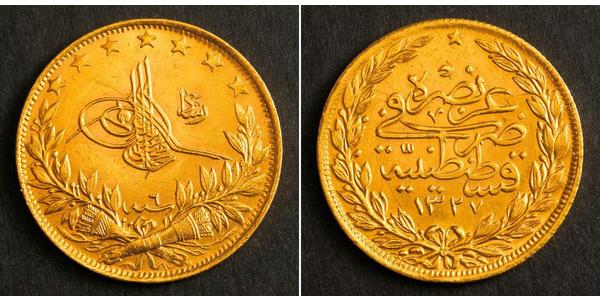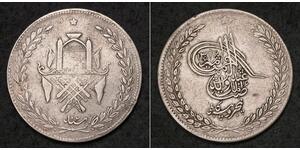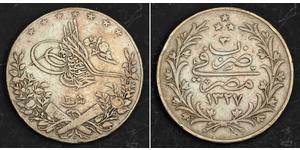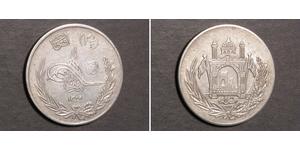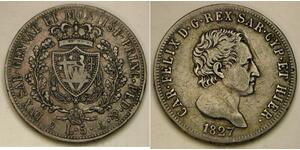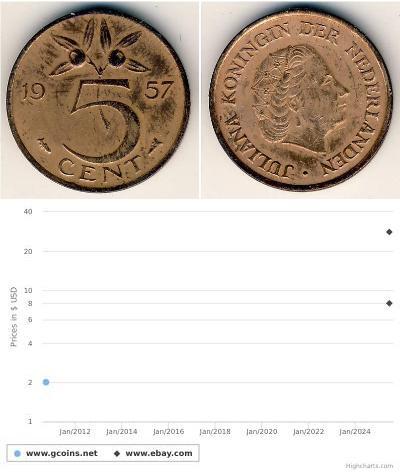(售价 $511.0)
1915, Ottoman Empire, Mehmed V. Beautiful Gold 100 Kurush Coin. (XF-AU!) 7.23gm!
Condition: A nice XF-AU! Denomination: 250 Kurush Mint Year: 1915 (1327AH+6) Reference: Friedberg 154, KM-754. Mint Place: Constantinople (Qustantiniyah) Material: Gold (.917) Diameter: 22mm Weight: 7.23gm
Obverse: State seal (Tughra) of the Sultan, above regnal year (6). Honorific title (reshat) in right field. Wreath below, seven stars above.
Reverse: Mint formula above mint name (Qustantiniyah = Constantinople) and accession year (1327). All within floral border.
Mehmed V (Turkish: Mehmed V Resad or Resat Mehmet) (November 2, 1844 – July 3, 1918) was the 35th Ottoman Sultan. He was the son of Sultan Abdülmecid I. His Mother was Gülcemal Kadin Efendi was of Circassian origin. Like many other potential heirs to the throne, he was confined for 30 years in the Harems of the palace. For nine of those years he was in solitary confinement. During this time he studied poetry of the old Persian style and was an acclaimed poet. On his ninth birthday he was ceremoniously circumcised in the special Circumcision Room (Sünnet Odasi) of Topkapi Palace.
His reign began on April 27, 1909 but he had no real political power. The actual decisions were made by various members of the Ottoman government and finally, during the First World War, by the Three Pashas: Enver Pasha, Talat Pasha, and Cemal Pasha.
Mehmed V's only significant political act was to formally declare Jihad against the Allies on November 11, 1914. This was the last genuine proclamation of Jihad in history by a Caliph, as the Caliphate lasted until 1924. The proclamation had no noticeable effect on the war, despite the fact that many Muslims lived in Ottoman territories. The Arabs eventually joined the British forces against the Ottomans with the Arab Revolt in 1916.
Mehmed V hosted Kaiser Wilhelm II, his World War I ally, in Constantinople on October 15, 1917.
Mehmed V died on July 3, 1918 at the age of 73, only four months before the end of World War I. Thus, he did not live to see the downfall of the Ottoman Empire. He spent most of his life at the Dolmabahçe Palace and Yildiz Palace in Constantinople. His grave is in the historic Eyüp district of the city. He left two sons: Prince Mehmed Ziyaeddin (1873-1938) and Prince Ömer Hilmi (1886-1935). His only daughter Princess Refia (1888) died as a baby. His son Prince Mehmed Necmeddin (1878-1913) was the son of Dürridem Kadin Efendi who was born in Kars and was of Georgian origin. She was the second wife, but divorced in 1887 and the concubine Mihrengiz took her place as the second wife.
Prince Mehmed Necmedinn was a lover of classical music. His only son, Prince Mehmed Saban Efendi (1909-1982), whose mother was Nihal Nur of Georgian origin, left Turkey 1924 and emigrated to Bulgaria.In the year 1966 they emigrated to Germany. He returned to Turkey with his family in 1980 and settled in Thrace. His wife was Princess Nemzade Hatice Sultan, a great-granddaughter of Sultan Abdülaziz I. Saban's youngest son, Sebahattin (1946-1998), remained in Germany and founded his family. He left only one son and heir: Prince Timur Can (1978).
5 Lira Italian city-states 銀 卡洛·費利切
本组有 18 钱币 / 16 售价
⇑

